| |
|
|
written by Jess Ragan (unless otherwise noted) inspired by The Incredibly Complete Pac-Man Game List by Josh Lesnick
SPACE
INVADERS
It's the game that started it all, folks! Well, if you don't count Tank, or Pong, or Space Wars, or that funky tennis game Doc Higganbothom made with his oscilloscope... all right, all right, so it's not the game that started it all. But you can't argue that Space Invaders took the video game industry to a whole new level with its advanced technology. "Is he calling Space Invaders advanced?" Why, yes I am! Sure, it may seem simplistic by today's high standards, but back in the late 70's, this game was state-of-the-art all the way. Most arcade games of the time used solid state technology... the designers would assemble a complex series of logic gates that when put together would play simple games. However, Taito used a microprocessor for Space Invaders, considerably broadening its horizons. The game wasn't chained to the limitations of the Pong clones that were popular in the 70's... Space Invaders could handle dozens of onscreen characters, rather than just two or three. Instead of simple lines and dots, everything in the game was drawn with sharp detail... the creatures looming above you were recognizable as aliens, and the flying object in the sky was anything BUT unidentifiable. Finally, instead of just sound, Space Invaders had sound effects. These ranged from the explosion of your tank to the threatening thump of the invaders' feet as they inched ever closer toward Earth. This sound quickly became a trademark of the series, and to this day, devoted fans will complain bitterly if the latest Space Invaders game doesn't have it. You're already familiar with the gameplay. You're defending Earth from armies of unrelenting aliens. These creatures march from one side of the screen to the other, then drop downward and repeat the process. It's your job to pick off the aliens with your powerful laser cannon before they reach the surface of the planet... and conquer it. Both strategy and skill are required to prevent this from happening. You'll find that killing columns of enemies slows down their advance, while vaporizing the bottom-most row gives you room to dodge the aliens' constant rain of bombs. You might want to blast a hole through the center of the invader formation as well, so you can fire at the flying saucers that occasionally drift by. Just remember that as aliens are destroyed, their comrades become more and more determined to accomplish their goal. When only one invader is left, it will make a mad dash for the surface of the planet. You'll have to be just as quick to frag the fiend, before you meet it face to hideous face. That's the long and short of Space Invaders. Sure, the game's been eclipsed by hundreds of other shooters in the twenty five years since it was introduced. However, it's doubtful that any of those games would exist if it hadn't been for the important advances Space Invaders had brought to the video game industry. SPACE
INVADERS
Chances are if you had an Atari 2600 in the 80's, this game spent as much time in its cartridge slot as any of the others in your collection. It may not be as flashy as Solaris, or as unique as Yar's Revenge, but it's just plain fun to play. The huge selection of options in Space Invaders extends its replayability well beyond that of the average 2600 game... you can choose to play with shifting barriers (try hiding under them now!), faster enemy bombs, or invisible invaders if you'd like. If all that's not enough to keep you happy, why not try the game with another player? You can compete simultaneously, switch control of the same laser cannon after every shot, or even play cooperatively, with one player manning the joystick and the other firing at the enemy. Now that's entertainment! The fact that the 2600 version of Space Invaders is only loosely based on the arcade game is surprisingly inconsequential. Yes, the graphics aren't at all accurate, and yes, there aren't as many invaders onscreen as there were in the arcade game, but that doesn't keep Space Invaders on the 2600 from being one of the best games on the system. Here's the best part... the game was produced in such large quantities that it's still easy to find. If you've thought about collecting Atari 2600 games, Space Invaders is as good a place as any to start. SPACE INVADERS DELUXE
(aka PART II)
Ladies and gentlemen, we're pleased to present the first true sequel to Space Invaders. Forget about Midway's hastily made Space Invaders II... this is the real thing, brought to you by the creators of the series. Space Invaders Deluxe isn't a quantum leap forward for the series the way that Return of the Invaders and Space Invaders '91 were, but it does add a few twists to the familiar formula. There are new UFOs, new enemy formations, and even a dangerous new invader which splits in half when you've hit it with a bullet. Taito also added color, and marked the barriers with the current round number so you'll know exactly how far you've gotten into the game. Nice touch, guys! Past that, Space Invaders Deluxe is the same game as the first. The invaders march down the screen, you shoot them... rinse, lather, repeat. The intermissions between rounds add some humor to the game, but they weren't entirely necessary. After all, Space Invaders doesn't exactly have what you'd call a lighthearted storyline. The only thing more frightening than the prospect of aliens coming to take over the world is being slaughtered by merciless, genocidal robots... or being endlessly pursued by a sinister space demon constructed piece by piece by its mindless followers. Or being pulled into a gaping hole by ravenous monsters! All right, so there are a lot of disturbing plots in video games, but an alien invasion ranks up there as one of the creepiest. SPACE INVADERS (aka
ASTRO
BATTLE)
At any rate, Space Invaders (or Astro Battle, if you prefer) is pretty much what you'd expect it to be... a straightforward translation of Space Invaders on the Astrocade. It's not loaded with options the way the Atari 2600 game was, but on the other side of the coin, the invaders are multicolored and there are more of them packed into each row. One big strike against Bally's version of Space Invaders is that the sound effects are obnoxious beyond belief. Whenever your ship fires, it lets loose a quivering squeal that sounds as if the Astrocade is trying to yodel... someone should just feed the damn thing a Ricola and tell it to shut the hell up. The UFO's appearance is announced with the ringing of a cordless phone, and the invaders' deaths don't sound remotely like any explosion I've ever heard. In fact, the entire game strikes me as being unprofessionally designed. The UFOs, referred to in the manual by the politically correct term "parent ships", come out whenever they feel like making an appearance, regardless of the number of invaders remaining onscreen. You'll see a rapid procession of UFOs in one round, only to spot almost none in the next. The shields protecting your ship are gigantic, the bright colors seem out of place, and the sound will drive you out of your bloody mind after a couple of rounds. For the time, this was a respectable translation of Space Invaders, but I'd rather play the game on the 2600, even with all its artistic liberties.
SPACE INVADERS
II
Such is the case with Space Invaders II. Don't confuse this with Taito's own Space Invaders Part II... that was the true sequel to the original game. Space Invaders II borrows elements from the largely forgotten Laser War, an arcade release intended for two players. Each player mans a ship on either side of the screen, and both ships are seperated by an stream of aliens. The ships blast a path through the aliens and eventually fire at one another, hoping to claim victory against their respective opponents. The main difference between Space Invaders II and Laser War is that in Midway's game, the aliens fight back. They march back and forth, raining bullets down on you (or up at you, if you're on the opposite edge of the screen) just as they would in any other Space Invaders game. There are UFOs as well, but they serve the additional purpose of dropping new recruits into each player's space armada. Your main goal is to eliminate the invaders, but an important secondary objective is to tag the other player with a bullet. Destroying your opponent's ship earns you an extra life, but take it easy on them... once the other player is gone for good, the only way you'll get additional lives is by earning points. Midway's approach to Space Invaders does an excellent job of getting a second player into the action, but it lacks the polish of the Taito original. The new invader designs are unmemorable and kind of silly, and the action is compressed to fit two games of Space Invaders onscreen at once. Finally, you'll have to play the game with two players to get the complete Space Invaders II experience... in a single player game, there's only one army of invaders, and the computer controls the other ship. It's still tough to hit, but it's a lot less satisfying to gloat about it afterwards.
SPACE
INVADERS
Yet, for all its inaccuracies, Space Invaders on the 5200 is a fun game, and an entertaining sequel to the equally loose 2600 port of Space Invaders. Its main advantage over both that game and the arcade version are new invaders, which are introduced every two rounds. Although these creatures look like they'd be more at home in Imagic's Demon Attack, they're nevertheless cleverly drawn and animated. If you're lucky enough to reach the later rounds, you'll battle an armada of shape-shifting aliens whose constant transformations are almost hypnotic... kind of like a lava lamp, or Homer Simpson's enormous, amorphous belly. Even if you're outraged by all of Atari's changes, it's still worth playing the 5200 version of Space Invaders just to see all the weird aliens the designers had cooked up.
RETURN OF THE
INVADERS
I guess I shouldn't be too surprised that Return of the Invaders was almost completely forgotten by gamers. It was released at the worst possible time, just after the infamous video game crash of 1984. The last thing people were interested in at the time was Space Invaders... if they were playing anything at all, it was a promising new side-scrolling adventure called Super Mario Bros. That's a shame, because Taito's advanced sequel to Space Invaders was pretty super in its own right. Return of the Invaders was an important step forward in the evolution of the Space Invaders series. The primitive green and black graphics from the previous games were put out to pasture, replaced with a wide variety of nicely detailed and shaded aliens marching inside a rocky cavern. If it weren't for the less elegant enemy formations, Return of the Invaders would look just as beautiful as its closest competitor, Namco's Gaplus. This enhanced sequel to Space Invaders sounds even better than it looks thanks to Zuntata. The mesmerizing soundtrack they'd written for Return of the Invaders is a sharp contrast to the threatening thumps the invaders made with every step in the first Space Invaders. Purists may not appreciate the more relaxed atmosphere this new soundtrack gives the game, but I happen to like the spacey new age tunes. They're beautifully written and really draw you into the game. Return of the Invaders isn't just Space Invaders with a pretty new face and voice... it's a true evolution of the series, with several features that have helped shape the design of future SI sequels. The UFOs flying overhead aren't just there for bonus points anymore. Winging one with a bullet awards you with a rapid fire gun that makes short work of the invaders. Just make sure that you hit the side of the mothership, because a direct hit in the center blows up both the UFO and its weapon. Return of the Invaders also introduces new enemy formations, hidden bonus rounds, and invaders that retaliate when hit. Sometimes they'll transform into something completely bizarre, like a pair of lips with wings, and dive toward you. Other times, they'll block your shots and respond with a lightning quick laser bullet that's very difficult to avoid. A few of them will even spiral away, as though they were tin cans blasted by a pellet gun in a carnival game. This gives Return of the Invaders a challenging new twist without turning it into a completely different game. The only truly bad thing about Return of the Invaders was Taito's bad timing. People never gave the game a chance when it was released, and nearly twenty years later, it will be tough for them to fully appreciate both its once exceptional audiovisuals and the advances it brought to the Space Invaders series. I can still recommend it, though, because despite its age, Return of the Invaders remains a solid game, and one of Taito's better Space Invaders releases. SPACE
INVADERS
Now that you know just what an MSX is, let's dive right into the review. Put simply, the MSX version of Space Invaders is good, but not great. Sure, it's a satisfactory translation of the arcade game, but some things in this version of Space Invaders just seem out of place. For instance, there's color now, but it doesn't really fit the mood... after getting an eyeful of the pastel purples and blues in the game, you'll swear the aliens hitched a ride to Earth in the Easter Bunny's basket (that long-eared traitor!). Also, the sound effects are high-pitched and barely audible... you'll hear a metallic ring whenever you fire your cannon, and the invaders chirp like finches when they're hit by your gunfire. It's much harder to take a game like Space Invaders seriously when it seems like the aliens have been replaced with a flock of angry parakeets. SPACE
INVADERS
Looks like I'll have to pad this review a bit, huh? Well, let's try this. Did you know that in a promotional pamphlet, Sega claimed that its SG-1000 was the first programmable video game system? Yep, really. I guess they conveniently forgot about all the other consoles that came out years before the SG-1000, like the Intellivision, the Atari 2600, the Astrocade, the... well, you get the idea. SPACE
INVADERS
It's not just the designers who should be blamed for this weak conversion of Space Invaders. Actually, it was mostly their faults, but there's also the issue of the hardware. The Nintendo Entertainment System is capable of a lot of things, but it just doesn't have the teeth for a truly faithful version of Space Invaders. The bright colors and chirpy sound effects don't do the game justice. The same thing could be said about the other 8-bit conversions of Space Invaders, except Atari's... the menace of the marching aliens completely vanishes when the thump of each step is replaced with a high-pitched blip. Nevertheless, the designers could have put a little more effort into this conversion. There are no alternate modes or color schemes, the invaders are tiny and inaccurately drawn, and even the font's not right. Taito did include the attract mode from the arcade game, but when you consider that this is an NES game, they could have given players a whole lot more.
Taito took a break from the Space Invaders series in the late 1980's, turning its attention toward new games like Rastan and Bubble Bobble. These games, featuring beautifully detailed graphics and more complex gameplay, were much more appealing to the Nintendo generation (although ironically, one of Taito's biggest hits from the 1980's was Arkanoid, a futuristic version of Atari's Breakout). It would be four long years before the invaders would return to Earth... |

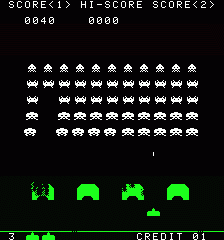
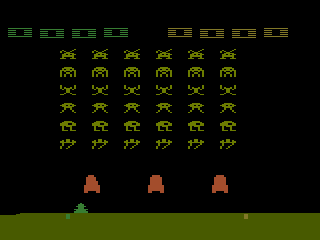 It
may not be much like the arcade game, but it's safe to say that
Space Invaders on the 2600 is just as fondly remembered by gamers
who grew up in the early 80's. Who could forget the silly
invader designs, including everything from an intergalactic
gorilla to a cyclops with two left feet? Or the countless game
options, which let you crank up the challenge to your liking or even
compete with a friend? Or the raw, powerful sound effects that
only the Atari 2600 could deliver? Nobody, that's
who.
It
may not be much like the arcade game, but it's safe to say that
Space Invaders on the 2600 is just as fondly remembered by gamers
who grew up in the early 80's. Who could forget the silly
invader designs, including everything from an intergalactic
gorilla to a cyclops with two left feet? Or the countless game
options, which let you crank up the challenge to your liking or even
compete with a friend? Or the raw, powerful sound effects that
only the Atari 2600 could deliver? Nobody, that's
who.
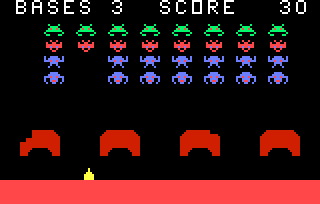 This one's more commonly known as Astro Battle, mostly
because the original manufacturers of the Astrocade, Bally, didn't
have the heart to compete against Atari in the home video game
console wars. When Bally sold the rights to the Astrocade to
Astrovision Inc., the rights to their arcade licenses weren't
included in the deal. The same thing happened to Namco's
Galaxian, which was renamed Galactic Battle. Why Atari didn't
sue Astrovision for distributing these games, even with the new
titles, is anyone's guess... perhaps they came to an agreement
with Bally before they'd sold the Astrocade, or maybe they just
didn't feel that the Astrocade was a strong enough competitor to be
worth their time.
This one's more commonly known as Astro Battle, mostly
because the original manufacturers of the Astrocade, Bally, didn't
have the heart to compete against Atari in the home video game
console wars. When Bally sold the rights to the Astrocade to
Astrovision Inc., the rights to their arcade licenses weren't
included in the deal. The same thing happened to Namco's
Galaxian, which was renamed Galactic Battle. Why Atari didn't
sue Astrovision for distributing these games, even with the new
titles, is anyone's guess... perhaps they came to an agreement
with Bally before they'd sold the Astrocade, or maybe they just
didn't feel that the Astrocade was a strong enough competitor to be
worth their time.
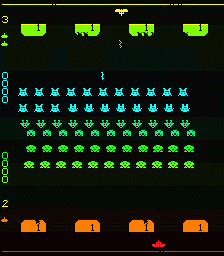 Bally/Midway never learned that designing its own sequels
to the games they'd licensed from Japanese companies was a lousy
idea. First of all, it's rude. Merely owning the license
to a game does not give you the right to spit out unauthorized
spinoffs for a quick buck. This was the kind of behavior that
eventually soured Midway's relationship with not only Taito, but its
rival Namco. Secondly, it makes the mistaken assumption
that you truly understand what makes the game work and that you can
repeat that success with an entirely different team of
programmers. This almost always results in an inferior
product; a cheap imitation that reflects negatively on the
franchise.
Bally/Midway never learned that designing its own sequels
to the games they'd licensed from Japanese companies was a lousy
idea. First of all, it's rude. Merely owning the license
to a game does not give you the right to spit out unauthorized
spinoffs for a quick buck. This was the kind of behavior that
eventually soured Midway's relationship with not only Taito, but its
rival Namco. Secondly, it makes the mistaken assumption
that you truly understand what makes the game work and that you can
repeat that success with an entirely different team of
programmers. This almost always results in an inferior
product; a cheap imitation that reflects negatively on the
franchise.
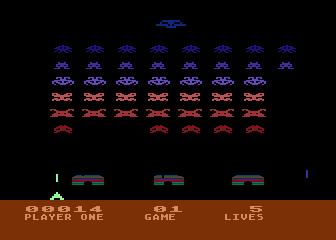 The
artistic liberties continue in Atari's loosest conversion yet of
Space Invaders. If you're looking for an accurate translation
of Taito's timeless classic, this ain't it. Absolutely nothing
in Atari's 5200 version of Space Invaders resembles the arcade
game... your laser cannon moves too quickly, the scoring
is much lower, the aliens don't look even remotely like
they once did, and even the sound effects aren't right.
The
artistic liberties continue in Atari's loosest conversion yet of
Space Invaders. If you're looking for an accurate translation
of Taito's timeless classic, this ain't it. Absolutely nothing
in Atari's 5200 version of Space Invaders resembles the arcade
game... your laser cannon moves too quickly, the scoring
is much lower, the aliens don't look even remotely like
they once did, and even the sound effects aren't right.

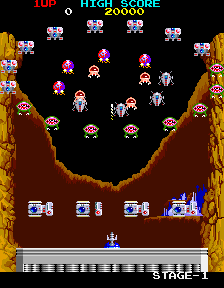
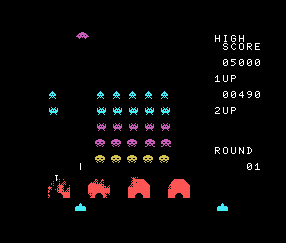 Since many of you may not be familiar with the MSX, a
little history lesson is in order. Before the XBox, Microsoft
dipped its toe into the video game market with this budget computer,
which accepted cartridges as well as floppy discs. Unlike the
XBox, this console was extremely popular in Japan, with
hundreds of titles by popular game designers like Konami, Namco, and
Hudson Soft. However, while the XBox achieved minor success in
America, the MSX was all but ignored thanks to the Commodore 64,
that other computer that thought it was a video game system (or was
it the other way around?). The only people in the United
States who paid any attention to it were aspiring
musicians, who got a lot of mileage out of its compatibility with
MIDI devices like keyboards.
Since many of you may not be familiar with the MSX, a
little history lesson is in order. Before the XBox, Microsoft
dipped its toe into the video game market with this budget computer,
which accepted cartridges as well as floppy discs. Unlike the
XBox, this console was extremely popular in Japan, with
hundreds of titles by popular game designers like Konami, Namco, and
Hudson Soft. However, while the XBox achieved minor success in
America, the MSX was all but ignored thanks to the Commodore 64,
that other computer that thought it was a video game system (or was
it the other way around?). The only people in the United
States who paid any attention to it were aspiring
musicians, who got a lot of mileage out of its compatibility with
MIDI devices like keyboards.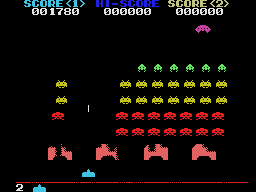 It's another Space Invaders conversion for another obscure
Japanese console. This one's a little better than the MSX
version... but just a little. The font's not accurate
and the game is entirely too colorful, but on the other hand,
the sound is more faithful to the arcade version, with slightly more
bass in the cannon fire and explosions. Also, the characters
are a bit larger than they were on the MSX. Other than that,
it's just another conversion of Space Invaders.
It's another Space Invaders conversion for another obscure
Japanese console. This one's a little better than the MSX
version... but just a little. The font's not accurate
and the game is entirely too colorful, but on the other hand,
the sound is more faithful to the arcade version, with slightly more
bass in the cannon fire and explosions. Also, the characters
are a bit larger than they were on the MSX. Other than that,
it's just another conversion of Space Invaders. It
shouldn't be too tough to figure out why this game wasn't released
in the United States. People just weren't ready to relive
their memories of Space Invaders... in their view, it was boring and
antiquated. This lackluster translation would only have
reinforced this opinion.
It
shouldn't be too tough to figure out why this game wasn't released
in the United States. People just weren't ready to relive
their memories of Space Invaders... in their view, it was boring and
antiquated. This lackluster translation would only have
reinforced this opinion.
